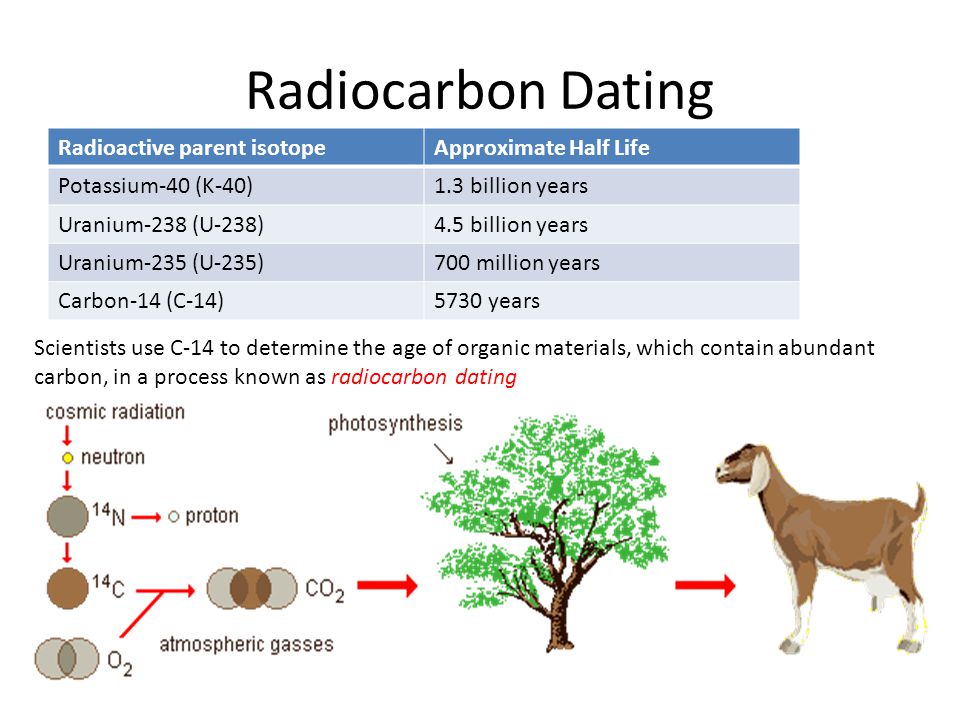
The carbon decays with its half-life of 5, years, while the amount of carbon remains constant in the sample. By looking at the ratio of carbon to carbon in the sample and comparing it to the ratio in a living organism, it is possible to determine the age of a formerly living thing fairly precisely. An essential piece of information in this research is the age of the fossils and artifacts. How do scientists determine their ages? Here are more details on a few of the methods used to date objects discussed in "The Great Human Migration". In this section we will explore the use of carbon dating to determine the age of fossil remains. Carbon is a key element in biologically important molecules. During the lifetime of an organism, carbon is brought into the cell from the environment in the form of either carbon dioxide or carbon-based food molecules such as glucose; then used to.
What Is Carbon Dating How Is It Used To Determine The Age Of Fossils. Carbon, Radiometric Dating - CSI

: What is carbon dating how is it used to determine the age of fossils
| Online dating true filipina |
63 |
| Top dating app for android |
In addition, anticoincidence detectors are used; these record events outside the counter, and any event recorded simultaneously both inside and outside the counter is regarded as an extraneous event and ignored. The results from AMS testing are in the form of ratios of 12 C13 Cand 14 Cwhich are used to calculate Fm, the "fraction modern". For accelerator mass spectrometrysolid graphite targets are the most common, although iron carbide and gaseous CO 2 can also be used. The precision of a dating method depends in part on the half-life of the radioactive isotope involved. These artifacts have gone through many carbon half-lives, and the amount of carbon remaining in them is miniscule and very difficult to detect. |
| HOOK UP HOTTIE YO YO |
292 |
The coprolites averaged about 14, years old and are some of the oldest human remains in the Americas. To produce a curve that can be used to relate calendar years to radiocarbon years, a sequence of securely dated samples is needed which can be tested to determine their radiocarbon age. Exposure to sunlight or heat releases these charges, effectively "bleaching" the sample and resetting the clock to zero. Amino acid racemisation Archaeomagnetic
dating sites redcar Dendrochronology Ice core Incremental dating Lichenometry Paleomagnetism Radiometric dating Radiocarbon Uranium—lead Potassium—argon Tephrochronology Luminescence dating Thermoluminescence dating. Absolute dating Amino acid racemisation Archaeomagnetic dating Dendrochronology Ice core Incremental dating Lichenometry Paleomagnetism Radiometric dating Radiocarbon Uranium—lead Potassium—argon Tephrochronology Luminescence dating Thermoluminescence dating. In nature, carbon exists as two stable, nonradioactive isotopes: The equation governing the decay of a what is carbon dating how is it used to determine the age of fossils isotope is: Before the advent of radiocarbon dating, the fossilized trees had been dated by correlating sequences of annually deposited layers of sediment at Two Creeks with sequences in Scandinavia. The extreme temperatures of the magma would just what is carbon dating how is it used to determine the age of fossils the bones. Other materials can present the same problem: For dates up to a few million years micastektites glass fragments from volcanic eruptions
most popular dating app in nigeria meteorites are best used. Because the time it takes to convert biological materials to fossil fuels is substantially longer than the time it takes for its 14 C to decay below detectable levels, fossil fuels contain almost no 14 Cand as a result there was a noticeable drop in the proportion of 14 C in the atmosphere beginning in the late 19th century. For most radioactive nuclides, the half-life depends solely on nuclear properties and is essentially a constant. Until this century, relative dating was the only technique for identifying the age of a truly ancient object.
What is carbon dating how is it used to determine the age of fossils -
Carbon dating has been used successfully on the Dead Sea Scrolls, Minoan ruins and tombs of the pharaohs among other things. Today's knowledge of fossil ages comes primarily from radiometric dating , also known as radioactive dating. Scientists can't tell whether the clock ran down a few days or millions of years ago. Samples from the past 70, years made of wood, charcoal, peat, bone, antler or one of many other carbonates may be dated using this technique. Nuclear tests, nuclear reactors and the use of nuclear weapons have also changed the composition of radioisotopes in the air over the last few decades.


-
-
-
-